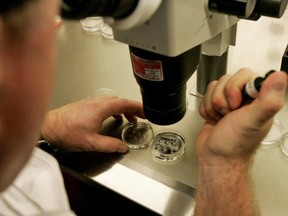Science
Scientists Convert Human Skin Cells into Fertilizable Eggs

In a groundbreaking achievement, scientists have successfully transformed human skin cells into fertilizable eggs and fertilized them with sperm in a laboratory setting. This significant advancement, announced on October 25, 2023, holds promise for providing potential solutions for infertility, which affects approximately one in six individuals worldwide.
The team of researchers, led by Paula Amato from the Oregon Health & Science University, cautioned that while this technology, known as in-vitro gametogenesis (IVG), could offer new possibilities for aspiring parents, its practical application is still at least a decade away. The research offers a proof-of-concept that could redefine infertility treatment, potentially enabling older women or those lacking viable eggs to engage in genetic reproduction.
Scientific Breakthroughs and Techniques
Amato emphasized the technology’s potential to benefit same-sex couples as well, allowing them to have children genetically related to both partners. This study, published in the journal Nature Communications, marks a notable progression in reproductive science, differentiating itself from prior research that primarily involved animal subjects.
In recent years, there have been significant strides in this field, including a study from Japan in July 2023, where researchers successfully created mice with two biological fathers. However, the current study is distinct as it utilizes human DNA rather than animal DNA.
To achieve this transformation, the scientists employed a technique known as somatic cell nuclear transfer, which involves transferring the nucleus from skin cells into a donor egg that has had its nucleus removed. This method was famously used to clone Dolly the sheep in 1996. One of the challenges faced in this process is that human skin cells contain 46 chromosomes, while eggs have only 23 chromosomes.
To address this issue, the researchers developed a novel process called “mitomeiosis,” which simulates the natural cell division process to remove the extra chromosomes. They successfully created 82 developing eggs, or oocytes, which were subsequently fertilized using in vitro fertilization (IVF) techniques. After six days, less than nine percent of the embryos had developed to a stage suitable for potential transfer to a uterus, a standard procedure in IVF.
Future Prospects and Challenges
Despite the low success rate, the researchers noted that during natural reproduction, only about one-third of embryos progress to the blastocyst stage, which is necessary for IVF. Amato stated, “The biggest hurdle is trying to achieve genetically normal eggs with the correct number and complement of chromosomes,” highlighting the complexities that remain in this pioneering research.
Ying Cheong, a reproductive medicine researcher at the University of Southampton in the UK, praised the study as an “exciting” breakthrough. She remarked, “For the first time, scientists have shown that DNA from ordinary body cells can be placed into an egg, activated, and made to halve its chromosomes.” Cheong emphasized the potential for this research to transform understandings of infertility and miscarriage and open doors for creating egg- or sperm-like cells for individuals who currently have no other reproductive options.
While other researchers are exploring different techniques, such as reprogramming skin cells into induced pluripotent stem cells, the timeline for widespread application remains uncertain. Amato reiterated, “It’s too early to tell which method will be more successful. Either way, we are still many years away.”
The study adhered to existing U.S. ethical guidelines regulating embryo research, ensuring a responsible approach to this transformative field of science. As this research progresses, it may redefine the landscape of reproductive options available to individuals and couples facing infertility challenges.
-

 Lifestyle1 month ago
Lifestyle1 month agoWinnipeg Celebrates Culinary Creativity During Le Burger Week 2025
-

 Health2 months ago
Health2 months agoMontreal’s Groupe Marcelle Leads Canadian Cosmetic Industry Growth
-

 Science2 months ago
Science2 months agoMicrosoft Confirms U.S. Law Overrules Canadian Data Sovereignty
-

 Education2 months ago
Education2 months agoRed River College Launches New Programs to Address Industry Needs
-

 Technology2 months ago
Technology2 months agoDragon Ball: Sparking! Zero Launching on Switch and Switch 2 This November
-

 Science2 months ago
Science2 months agoTech Innovator Amandipp Singh Transforms Hiring for Disabled
-

 Technology2 months ago
Technology2 months agoGoogle Pixel 10 Pro Fold Specs Unveiled Ahead of Launch
-

 Science2 months ago
Science2 months agoChina’s Wukong Spacesuit Sets New Standard for AI in Space
-

 Technology2 months ago
Technology2 months agoWorld of Warcraft Players Buzz Over 19-Quest Bee Challenge
-

 Science2 months ago
Science2 months agoXi Labs Innovates with New AI Operating System Set for 2025 Launch
-

 Business2 months ago
Business2 months agoDawson City Residents Rally Around Buy Canadian Movement
-

 Business2 months ago
Business2 months agoNew Estimates Reveal ChatGPT-5 Energy Use Could Soar
-

 Technology2 months ago
Technology2 months agoInnovative 140W GaN Travel Adapter Combines Power and Convenience
-

 Technology2 months ago
Technology2 months agoFuture Entertainment Launches DDoD with Gameplay Trailer Showcase
-

 Technology2 months ago
Technology2 months agoGlobal Launch of Ragnarok M: Classic Set for September 3, 2025
-

 Education2 months ago
Education2 months agoAlberta Teachers’ Strike: Potential Impacts on Students and Families
-

 Technology2 months ago
Technology2 months agoArsanesia Unveils Smith’s Chronicles with Steam Page and Trailer
-

 Technology2 months ago
Technology2 months agoNew IDR01 Smart Ring Offers Advanced Sports Tracking for $169
-

 Technology2 months ago
Technology2 months agoHumanoid Robots Compete in Hilarious Debut Games in Beijing
-

 Science2 months ago
Science2 months agoNew Precision Approach to Treating Depression Tailors Care to Patients
-

 Health2 months ago
Health2 months agoGiant Boba and Unique Treats Take Center Stage at Ottawa’s Newest Bubble Tea Shop
-

 Technology2 months ago
Technology2 months agoQuoted Tech Launches Back-to-School Discounts on PCs
-

 Business2 months ago
Business2 months agoBNA Brewing to Open New Bowling Alley in Downtown Penticton
-

 Technology2 months ago
Technology2 months agoDiscover the Relaxing Charm of Tiny Bookshop: A Cozy Gaming Escape










